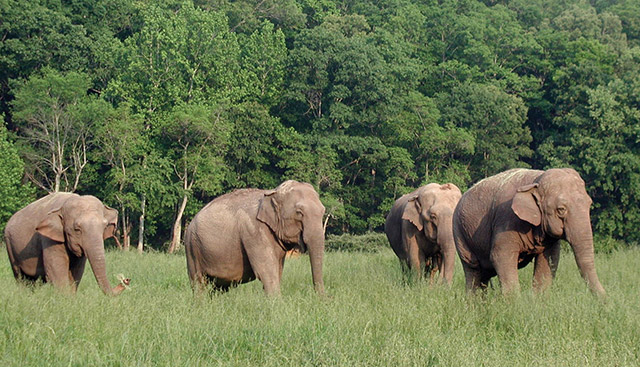Debbie, Queenie, Lottie, Minnie 2006
It has been ten years since The Elephant Sanctuary in Tennessee welcomed eight new elephants – Minnie, Lottie, Queenie, Liz, Debbie, Ronnie, Billie, and Frieda –all elephants transferred from the Hawthorn Corporation, a company that trained and leased elephants to circuses. These eight were not the first "Hawthorn" elephants to arrive at The Sanctuary. Delhi arrived in 2003. Misty and Lota followed in 2004. The elephants all came to The Sanctuary as the result of a long investigation into Hawthorn by the USDA for violations of the Animal Welfare Act. After years of performance and confinement, The Sanctuary provided these elephants with something completely unfamiliar to them: open skies, acres of green meadows and forested hillsides, ponds, and heated barns. Most importantly, the elephants were given the opportunity to choose how to spend their time.
Background
Although the well-being of performing elephants was already being called into question by animal welfare groups, a tragic incident in 1994 brought the issue to the attention of the general public. Tyke, a female African elephant owned by Hawthorn and performing with a circus in Honolulu, attacked a handler and then fled the circus arena. For half an hour, she ran amok across several city blocks. She was eventually brought down by local police and euthanized by Honolulu Zoo staff.1 The whole incident was filmed and aired on news outlets across the country. Many wondered what sort of treatment would cause such an outburst in a "trained" elephant, and public concern for the animals' welfare grew.
Adding to concerns was the discovery of tuberculosis amongst the Hawthorn herd. In 1996, Asian elephants Joyce and Hattie both passed away. TB was discovered to be the cause. Subsequent testing revealed that TB exposure was widespread in the Hawthorn herd. This wave of diagnoses marked the first time during the modern era that TB was detected in captive elephants in North America. Adhering to USDA mandates, the entire Hawthorn herd was sequestered and treated. They were back out on the road in a year.2 From 1997-2002, Hawthorn's elephants performed all over the United States. The Hawthorn Corporation was cited repeatedly for failing to provide adequate veterinary care and for failing to address the health and safety of its elephants.3
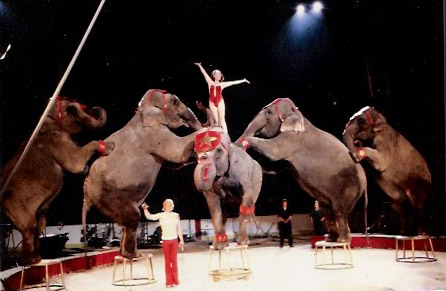
Hawthorn Five performance, date and location unknown
On April 9, 2003, the USDA cited Hawthorn with forty-seven violations of the Animal Welfare Act. In her 2014 book, Last Chain on Billie: How One Extraordinary Elephant Escaped the Big Top, Carol Bradley writes:
The law had long been criticized for setting bare minimum standards for animal care. Now, USDA was saying, Hawthorn wasn't even meeting those. The violations involved a dozen of [Hawthorn owner] John Cuneo's elephants; trainers were said to have used physical abuse to train, work, and handle the elephants, causing them discomfort and physical harm; failing to provide medical care for an emaciated elephant (Lota) and to an elephant suffering from acute chemical burns and a bacterial infection (Delhi); failing to provide veterinary care to several elephants, including Billie, who suffered from potentially lethal foot problems; and allowing unsafe contact with the public.
The charges filed by the USDA in 2003 were the culmination of a long investigation, and the ensuing litigation would be a lengthy process. Deciding immediate action was necessary for her safety, the USDA confiscated Delhi. Delhi had a series of serious health problems, including pododermatitis and osteoarthritis (inflammatory diseases affecting feet and joints) thought to be caused by standing and walking for long periods on hard substrates. One foot had serious chemical burns, having been dipped in undiluted formaldehyde, allegedly in a misguided attempt to treat her foot condition. Delhi’s name was mentioned frequently in the USDA’s prosecution claims. The Elephant Sanctuary agreed to provide Delhi a home.
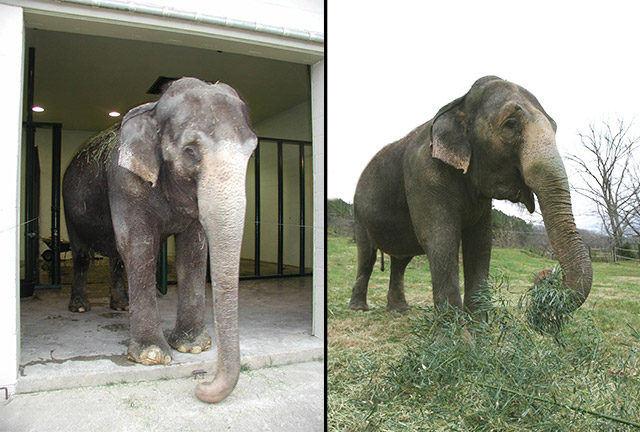 Delhi, soon after arrival, 2003 Delhi eating bamboo, early 2004
Delhi, soon after arrival, 2003 Delhi eating bamboo, early 2004
Delhi, the first elephant ever confiscated by the USDA, arrived at The Sanctuary on November 23rd, 2003. After spending the required amount of time in quarantine, Delhi joined the Asian herd the following year. After a couple of months getting to know the new habitat at her own pace, she began spending more and more time in the company of the Asian elephants. The EleCams recorded her swimming in the ponds and grazing alongside Tarra, Shirley, Winkie, Sissy, Jenny, and Bunny.
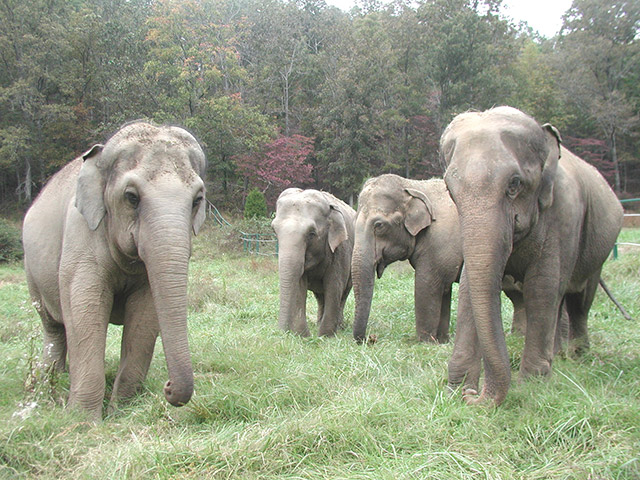
Tarra, Delhi, Winkie, Sissy, 2004.
In March of 2004, the Hawthorn Corporation reached an agreement with the USDA in which its remaining elephants would be relinquished to facilities approved by the latter. Hawthorn would also pay a $200,000 fine.4 Finding suitable homes for 16 Asian and African elephants, male and female, was no small task. The Elephant Sanctuary had room for two more Asian females. In November of 2004, one year after Delhi’s arrival, Lota and Misty arrived at The Sanctuary. Both had tested positive for TB exposure. Both would be held in the quarantine facility. Lota, herself now a symbol for the fight to free abused captive elephants, was very ill upon arrival and passed away two and half months later. A necropsy confirmed tuberculosis as the cause of her death.
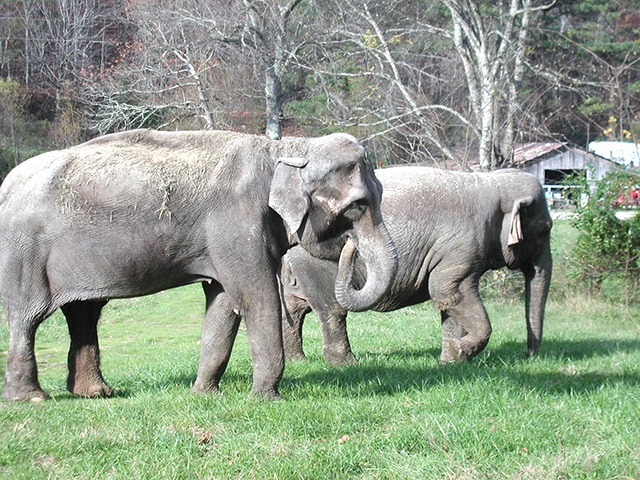
Lota and Misty after arrival, 2004.
The Elephant Sanctuary offered to take the remaining eleven female elephants even though The Sanctuary did not yet have the necessary barn facilities. Plans were quickly made to build a new barn for the current residents, allowing the Hawthorn herd to move into the "old" barn once necessary improvements had been made to meet the USDA requirements for quarantine for the exposed elephants. The barn would be known as the Quarantine or “Q” Barn. The necessary funds were raised thanks to The Sanctuary's supporters and animal rights organizations; construction was completed in late 2005.
During this time, three-way negotiations were still underway among The Sanctuary, the USDA, and the Hawthorn Corporation. After a period of time, Hawthorn agreed to send nine Asian females to The Elephant Sanctuary: Sue, Minnie, Lottie, Queenie, Liz, Debbie, Ronnie, Frieda, and Billie. Joy went to the Endangered Ark facility in Oklahoma. Nicholas, a bull calf born to Ronnie in 1993, was transferred to the Performing Animal Welfare Society Sanctuary in California. Gypsy, an Asian female, accompanied Nicholas to California. Tragically, Sue passed away before she could be transported to Tennessee.
The "founding Asian herd," including Delhi, was moved into the newly constructed Asia Barn and Habitat in January of 2006 to make way for the new arrivals from Hawthorn.
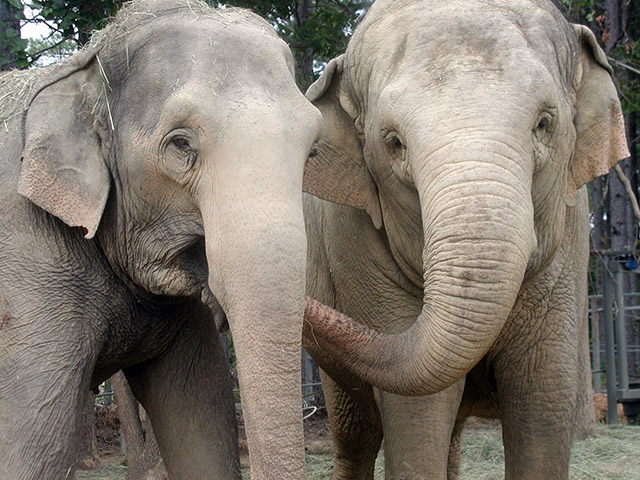
Delhi and Misty, 2006
Misty joined Delhi and the others in the Asia Habitat several months later, her quarantine and treatment for TB exposure complete. After stepping out of her trailer that transported her from one side of The Sanctuary to the other, Misty immediately walked to Delhi and the two shared trunk touches and sniffed one another all over…old companions reunited.
2006
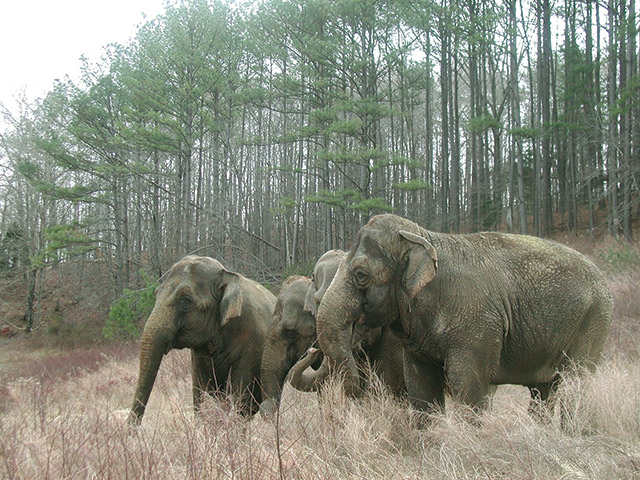
Debbie, Ronnie, Lottie, Minnie, 2006
Between January 31st and February 9th, 2006, eight elephants travelled to The Sanctuary via four trips in a trailer outfitted specifically for this purpose. Once arrived, these eight elephants (Minnie, Lottie, Queenie, Liz, Debbie, Ronnie, Billie, and Frieda) who had spent years together in the same barn chained in place for much of the day, had their first opportunities to socialize freely. Their first few weeks and months at The Sanctuary were spent exploring the Quarantine Habitat. Friendships were formed and reaffirmed. Minnie, Queenie, and Lottie became very close. Debbie and Ronnie were inseparable. They quickly began traveling farther out into the habitat, while the duo of Liz and Frieda stayed nearer the barn.
Billie, initially appearing anxious and wary around the other elephants (especially the very large Debbie and Minnie), began spending all of her time with Liz and Frieda. The elephants had access to ponds, woods, and wide open spaces for the first time in a very long time. Personalities emerged. The Sanctuary's live-streaming EleCams allowed viewers to watch as Debbie and Ronnie splashed in the pond and as Billie showed her proclivity as a "ballplayer," kicking around the large boomer balls placed in the habitat for enrichment.
2007
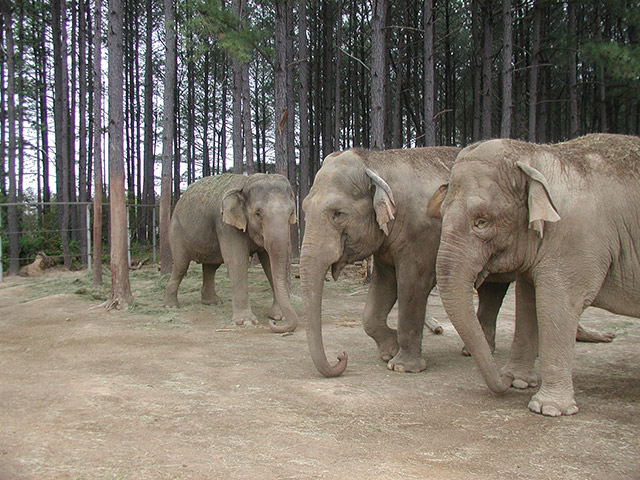
Dulary, Delhi, Misty, 2007
Delhi and Misty gained a new companion in 2007 when Dulary arrived from the Philadelphia Zoo. The three were often seen together, yet another mini-herd at The Sanctuary.
2008
After five years exploring The Sanctuary in the company of her herd, Delhi passed away in 2008. She was 62 years old. Misty and Dulary became very close, always staying near one another, often swimming in the pond near the Asia Barn built for Dulary.
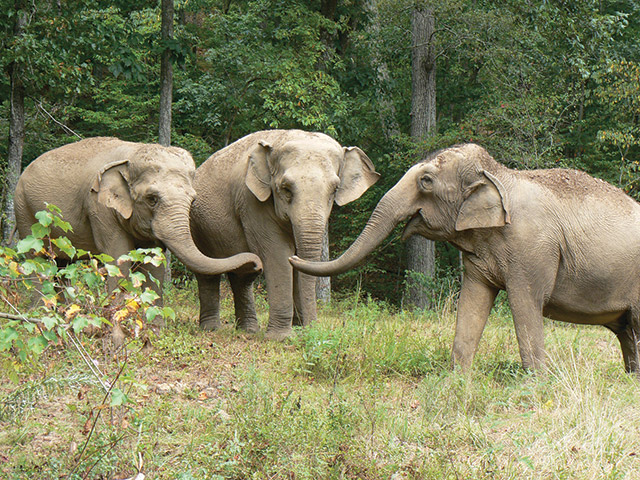
Ronnie, Debbie, Queenie, 2008
Queenie passed away in 2008 at the age of 49, having outlived her performing partner Tyke by 14 years.
2009
Sadly, Liz developed an active case of tuberculosis. She was moved to a separate area for quarantine and treatment. This newly created habitat area became known as the Phase I Barn and Habitat. The elephants in the two areas could still see, smell and hear one another, but they were separated by open space corridors and had separate barns.
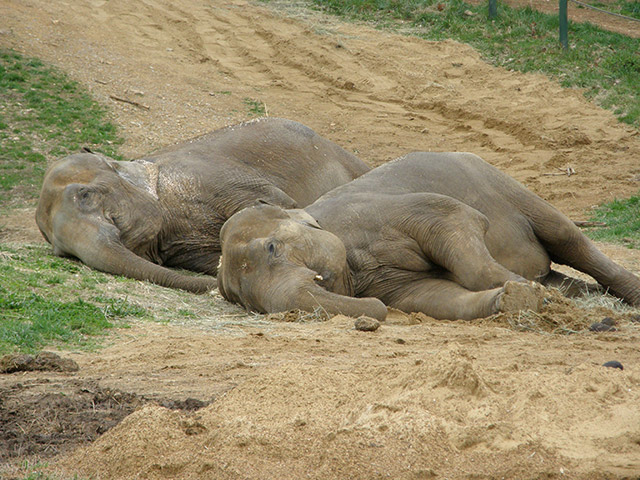
Liz and Frieda napping together, 2009
Frieda and Billie moved with Liz to avoid the added trauma of another separation. In their new habitat, the threesome appeared to become closer than ever.
2010
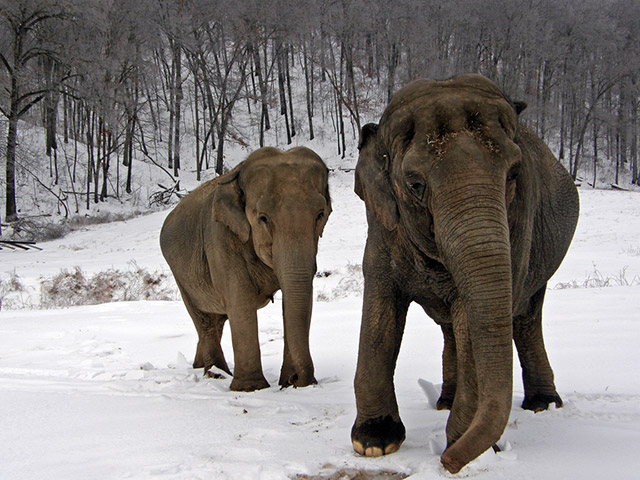
Lottie and Minnie in the snow, 2010
In May, the rain came to Middle Tennessee causing disastrous flooding throughout the region. Minnie, however, seemed to revel in the new lakes created by rising streams in the Q Habitat valley.
Lottie passed away in October at the age of 47. With Both Queenie and Lottie gone, Minnie was without close companions. Minnie and Debbie – two dominant elephants – competed to see who would be "in charge" of the three, sometimes jostling and pushing one another. For the wellbeing of all three, Minnie was given access to an area of the habitat separate from Debbie and Ronnie, though they could still see and touch one another through the fence separating them. Sanctuary Staff arranged for regular "play-dates" when the three could be together while being closely monitored. These events would usually end when the elephants lost interest or when they began showing signs of anxiety.
2011
LAST CHAIN ON BILLIE
The Sanctuary community had another reason to celebrate in May, 2011 when Billie allowed her ankle chain to be removed. Billie arrived at The Sanctuary in 2006 with the chain dangling loosely around her left, front ankle. During Billie's years as a circus elephant, the chain was used to shackle her in place. Even after Billie was no longer traveling and confined permanently in a 20' x 20' stall at the Hawthorn barn, her chain remained in place. For years after Billie's arrival, she would allow no one to touch it. Once at The Sanctuary, Billie and the other elephants interacted with Caregivers using a system called Protected Contact in which the elephants can choose to engage and disengage in training sessions at their own discretion. Staff and elephant are always separated by a protective barrier. In time, Billie began to show more trust and patience with Caregivers and fewer signs of anxiety. After five years, Billie allowed Caregivers to remove her chain – the last physical remnant of her life in performance.
The threesome of Billie, Liz, and Frieda filled the Quaratine Habitat with the sounds of their very vocal reunions after even the shortest of times apart. Staff often observed Liz and Billie watching over Frieda as she slept. As with many elephants from a performing background, Frieda suffered from chronic debilitating foot and joint issues, including osteomyelitis and pododermatitis. Complications stemming from foot and joint disease is a leading cause of death for captive elephants.
2013
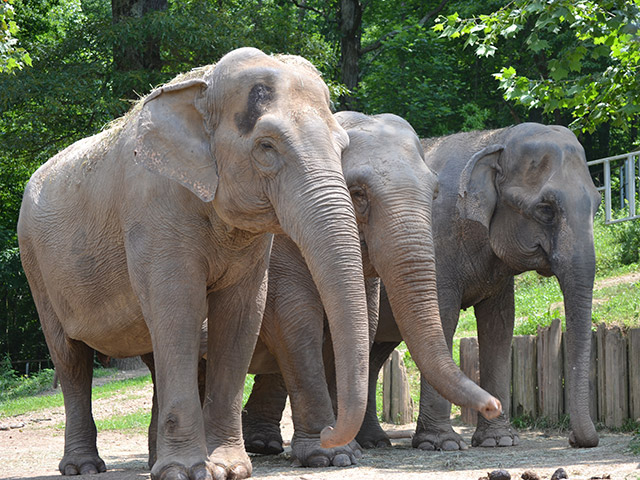
Frieda, Billie, Liz, 2013
An expansion to the Phase I Habitat gave Liz, Billie, and Frieda access to new hillsides behind their barn. Living up to her nickname of "Pathfinder," Frieda led the way.
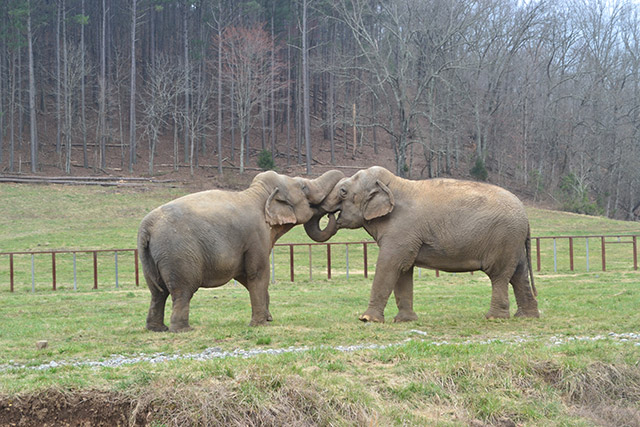
Ronnie and Minnie, 2013
Debbie, Ronnie, and Minnie's playdates continued, sometimes including playful jostling between Ronnie and Minnie.
2014
At the Asia Habitat, Misty started the year dealing with the loss of Dulary, who'd passed away the previous December at the age of 50. Over the course of the winter, Staff observed Tarra and Shirley spending time with Misty.
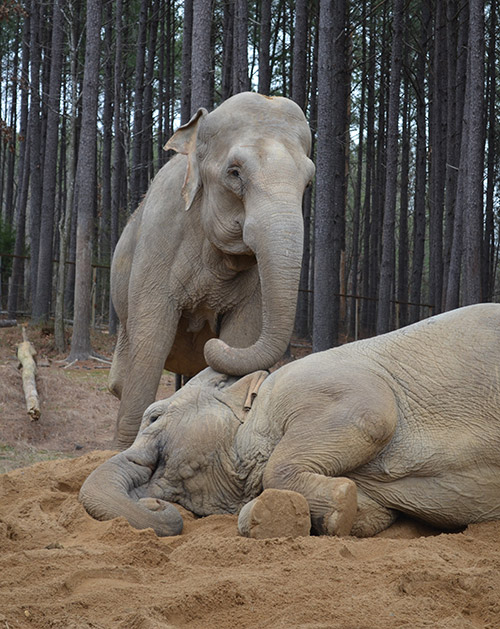
Shirley and Misty, 2014
Staff were amazed to see Shirley standing over Misty while she rested, her trunk gently resting on the sleeping elephant's head. In late Spring 2014, to the delighted surprise of all watching on the EleCams, Misty made the one-mile trek to the Highland Lake and went for a swim…a first for her.
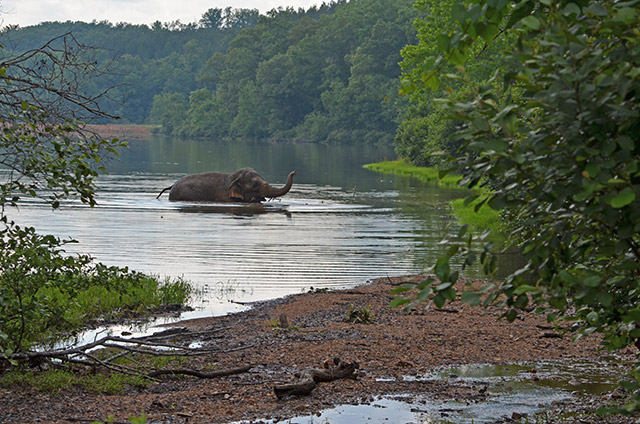
Misty, 2014
Misty spent the rest of the summer and fall in the far reaches of the Asia habitat with Tarra and Shirley.
She was even spotted in areas of the habitat not visited by other elephants, special areas of the habitat seemingly known only to her.
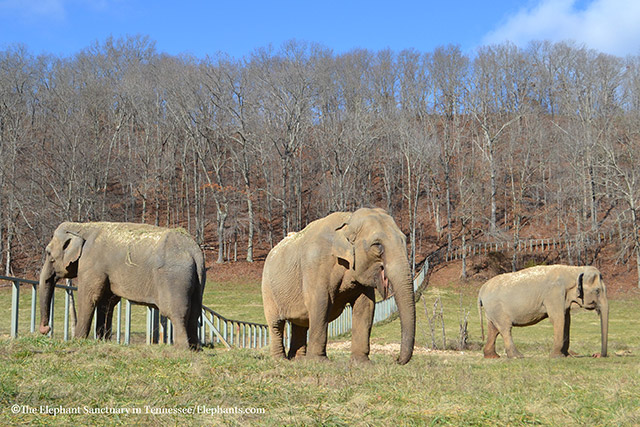
Frieda, Billie, Liz 2014
2015
After nine years in sanctuary, Frieda passed away in early 2015 at the age of 49. Liz followed later the same year at age 58. Both suffered from chronic illnesses associated with elephants in captivity such as osteomylelitis, arthritis, and TB exposure. Following Liz's passing, Staff observed Ronnie reaching over the fence separating her habitat from Billie's and touching Billie's head and back with her trunk.
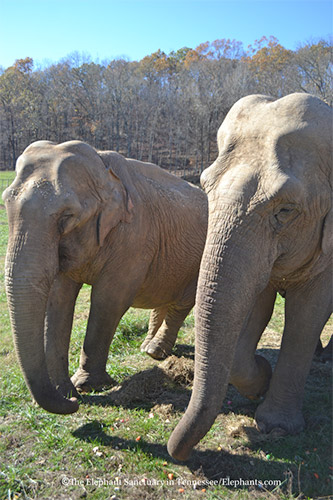
Billie and Ronnie, 2015
Caregivers soon began regular "play-dates" for Billie and Ronnie in hopes that they would form a stronger bond.

Misty at the lake, 2015
Misty returned to the lake in early Spring and again spent much of the summer and early fall in the far reaches of the Asia Habitat..to the excitement of The Sanctuary community.
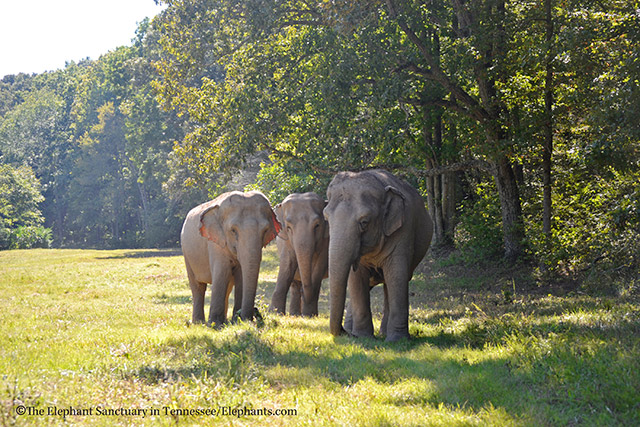
Ronnie, Debbie, Minnie 2015
Late in the summer of 2015 just after Liz's passing, Minnie, Debbie, and Ronnie had another play-date. At the end of the day, there were no signs of the elephants tiring of one another. Rather, they were still socializing and interacting. So the play-date turned into an overnight…and then another day, another night, a week, a month, and so on.
2016
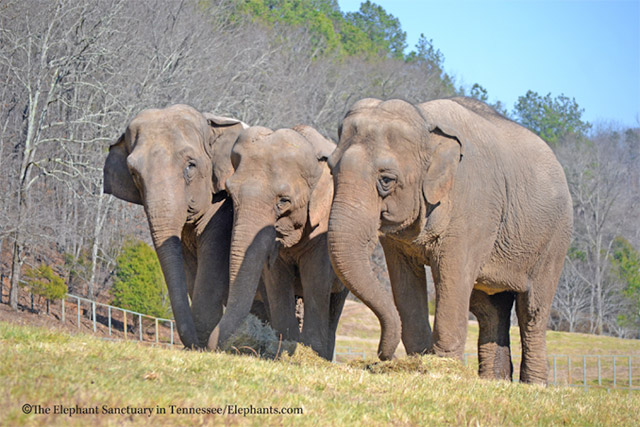
Debbie, Ronnie, Minnie, 2016
2016 will be the tenth year at The Sanctuary for Billie (now age 54), Debbie (45), Minnie (50), and Ronnie (50); it is the 12th year for Misty (52). In their years at The Sanctuary, they have reaffirmed old friendships and created new ones. Debbie, Minnie, and Ronnie are now a trio [adopt the Trio] spending much of their time together. Billie and Ronnie have regular play-dates, and Staff are excited to see the relationship develop between them. They have taught the elephant care community much through their stories, adding to the knowledge that will hopefully improve living conditions for elephants everywhere. At The Sanctuary, all elephants are routinely monitored by triple sample trunkwashes and serological testing. All elephants with known reactive TB exposure have been treated. Like their cousins in the wild, these elephants have explored new areas of their habitats, revisiting favored areas at certain times of the year. Staff are hopeful Misty will again choose to return to the areas around the lake in the spring to meet up with Tarra and Shirley. Also like their wild relatives, these elephants have mourned the loss of herd members: Queenie, Delhi, Lottie, Lota, Frieda, and Liz. For elephants that spent decades alternating between performing, traveling, and being confined in a dark barn…The Sanctuary has provided a new and very different life.
The Elephant Sanctuary in Tennessee is honored to partner with thousands of donors in providing a forever home for all 27 elephants that have retired here. It is the generosity of supporters that makes all of this possible.
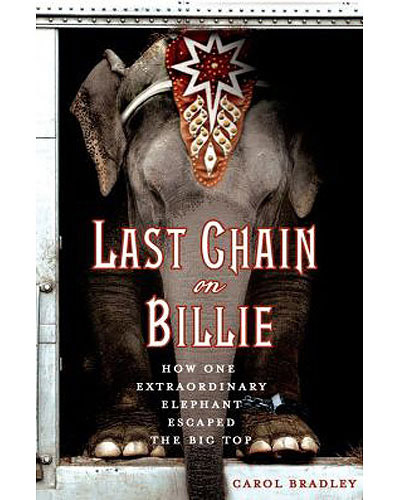
For more information about the Hawthorn Herd's life in circuses and journey to The Sanctuary, The Sanctuary Staff recommend reading Last Chain On Billie: How One Extraordinary Elephant Escaped the Big Top by Carol Bradley. ORDER NOW.
Staff also recommend the 2015 documentary Tyke: Elephant Outlaw , available now on Netflix and Video on Demand.
___________________
1 Bradley, Carol, Last Chain on Billie, (New York: St. Martin's Press) 2014, p.91
2 Bradley, Carol, Last Chain on Billie, (New York: St. Martin's Press) 2014, p. 110-111
3 Bradley, Carol, Last Chain on Billie, (New York: St. Martin's Press) 2014, p. 114-115
4 Bradley, Carol, Last Chain on Billie, (New York: St. Martin's Press) 2014, p.138

